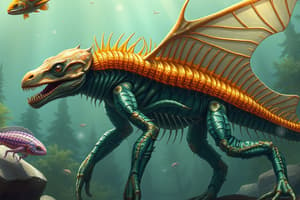Podcast
Questions and Answers
What is the definition of Porifera?
What is the definition of Porifera?
- sponge (correct)
- anemone
- hookworm
- earthworm
What is the definition of Cnidaria?
What is the definition of Cnidaria?
- hookworm
- fluke
- sponge
- anemone (correct)
What is the definition of Nematoda?
What is the definition of Nematoda?
- earthworm
- fluke
- hookworm (correct)
- squid
What is the definition of Annelida?
What is the definition of Annelida?
What is the definition of Platyhelminthes?
What is the definition of Platyhelminthes?
What is the definition of Arthropoda?
What is the definition of Arthropoda?
What is the definition of Molluska?
What is the definition of Molluska?
What is the definition of Echinodermata?
What is the definition of Echinodermata?
What benefits do arthropods provide to humans?
What benefits do arthropods provide to humans?
What do mollusks have?
What do mollusks have?
How do some mollusks move?
How do some mollusks move?
What significant characteristic do Porifera exhibit?
What significant characteristic do Porifera exhibit?
What type of symmetry do Cnidaria have?
What type of symmetry do Cnidaria have?
What type of organism is classified under Nematoda?
What type of organism is classified under Nematoda?
What characteristic of Arthropoda is related to their growth?
What characteristic of Arthropoda is related to their growth?
What type of organism does the term Platyhelminthes refer to?
What type of organism does the term Platyhelminthes refer to?
Flashcards are hidden until you start studying
Study Notes
Invertebrate Phyla Overview
- Porifera: Commonly known as sponges; characterized by no symmetry, lack of true tissues or organs, and filter feeding methods.
- Cnidaria: Includes organisms like jellyfish, corals, and anemones; known for radial symmetry and tentacles with stinging appendages for feeding.
- Nematoda: Also referred to as roundworms; includes hookworms and pinworms, exhibiting a simple body plan.
- Annelida: Segmented worms such as earthworms and leeches; used medically for wound healing and classified by the number of segments and appendages.
- Platyhelminthes: Known as flatworms; includes flukes and tapeworms, recognized for their flattened body shapes.
- Arthropoda: This diverse group includes insects, spiders, and crustaceans; characterized by an exoskeleton that requires molting for growth and segmented bodies.
- Molluska: Includes organisms like squids, snails, clams, and octopuses; many possess hard shells, large well-developed eyes, and utilize jet propulsion for movement.
Additional Characteristics
- Stationary Adult Forms: Porifera adults remain fixed in place throughout their lives.
- Medical Benefits: Annelids, such as leeches, can aid in the healing of wounds.
- Hard Shells and Jet Propulsion: Mollusks often have hard protective shells, and both mollusks and cnidarians exhibit jet propulsion via muscular contractions.
- Ecosystem Contributions: Arthropods play key roles in pest control and provide various benefits to human societies.
Symmetry and Body Structure
- Asymmetry: Demonstrated by Porifera, which lack symmetrical body plans.
- Radial Symmetry: Seen in both Cnidaria and Echinodermata, allowing for uniform interaction with the environment from all sides.
- Segmented Structures: Annelida and Arthropoda are classified based on their segmentation and the number of appendages.
Notable Species
- Echinodermata: Examples include sand dollars, sea stars, and sea urchins, showcasing unique body structures and adaptations.
- Global Diversity: Arthropoda includes a wide range of species such as ants, butterflies, and grasshoppers, demonstrating vast ecological diversity.
Studying That Suits You
Use AI to generate personalized quizzes and flashcards to suit your learning preferences.




